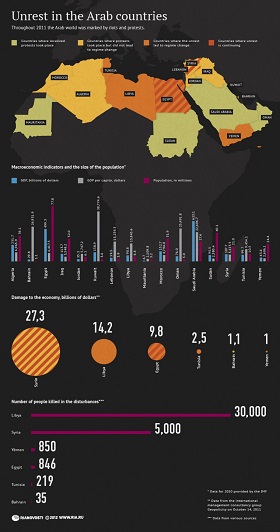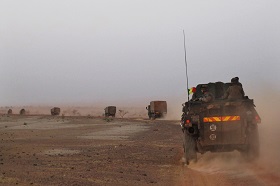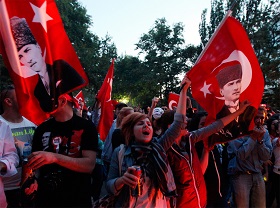During the Cold War, conflicts in the Middle East tended to be localized. Despite the Arab-Israeli Wars and inter-Arab rivalries, the region as a whole, from Morocco to Iran, remained relatively stable. This changed on December 17, 2010 in Tunisia, when Mohamed Bouazizi committed suicide by self-immolation to protest government abuse and corruption. His solitary act ignited the “Arab Spring”, a series of rebellions, revolts, coups, and civil wars against regimes across the Middle East. Amid this ongoing violence and political polarization, the region has become increasingly destabilized with some countries on the brink of fragmentation.
Two Precursors to The Arab Spring
The phrase “Arab Spring” was created as an umbrella term by the media to describe various local protest movements that have emerged throughout the Middle East since December 2010, seeking an end to corrupt and authoritarian regimes. This movement contained two elements: Islamists and Secularists, each suspicious of the other. Initially, it was thought that the “Arab Spring” would remake the political order of the Middle East. But to what end? General Rachid Ammar, chief of the Tunisian Army, remarked on June 26, "Tunisia could see the same fate as Somalia". Egypt is polarized. Libya, Mali, and Yemen are imploding. Borders are just lines on a map. Power increasingly resides in local militias. In many cases, only Islam can successfully transcend tribal differences and promote political cohesion. But this all changed in Syria where the “Arab Spring” grew into a sectarian war between Sunnis and Shias with the potential to engulf the region.
The current situation lies in stark contrast to that of 50 years ago when the future seemed to belong to a secular, Arab nationalism. What happened? Prior to 1952 and the rise of Gamal Abdul Nasser of Egypt, Arab nationalism had been narrow in scope. In 1916, Arab tribes led by Sharif Hussein of Mecca waged war against the Ottoman Empire to establish an independent Arab state. Since that Arab state was to be based on Sharia law, it was a precursor to the Islamist element in the “Arab Spring”.
However, the peace treaties ending World War I did not establish an independent Arab state. Instead, Arab lands were awarded to the British and French. Syria was divided. The north went to the French who partitioned it into five states – Aleppo, Damascus, Alawite, Druze, and Greater Lebanon. The south went to the British who partitioned into two– Palestine and Transjordan. To the east, the Ottoman provinces of Mosul, Baghdad, and Basra were combined to form the British administered Kingdom of Iraq.
After World War II, London and Paris ensured there were pro-Western governments in Syria and Iraq. But due to defeat in the Israeli War of Independence in 1948, inability to resolve the issue of Palestinian refugees, a dependence on Western support for survival, and for Iraq, entrance into the West’s anti-Soviet alliance, Central Treaty Organization, Damascus and Baghdad lost credibility at home. The governments in Syria and Iraq became unstable.
During this political crisis, the policies of Gamal Abdel Nasser of Egypt exerted a growing influence on Arabs in the Levant. Nasser was a precursor to the Secularist element in the “Arab Spring”. He transformed Arab nationalism by secularizing Arab identity. An Arab was now anyone, regardless of religion, whose mother tongue was Arabic. Nasser’s Arab nationalism did not seek to re-establish the Caliphate or impose Sharia law. It called for the political unification of the Arab nation modeled on the German and Italian unification movements of the 19th Century.
The decade 1958 to 1967 witnessed the rise and fall of Nasser’s Arab nationalism. In 1958, the Syrian government sought political unification with Egypt under Nasser. But the United Arab Republic was established as a unitary state with Egyptians occupying many of the political posts in Syria. In 1961, Syrian army units rebelled and proclaimed Syria’s independence. The dream of Arab unification ended with the defeat of Egypt by Israel in the 1967 War. Three years later, Nasser died of a heart attack at age 52. Without Nasser, secular Arab nationalism withered.
The Arab Spring and the Rise of Islamism
The West, and the U.S. in particular, appeared to be caught off guard by the political upheavals that overthrew its traditional allies of Ben Ali in Tunisia and Mubarak in Egypt. Inconsistent responses have undermined the credibility of the West, as well as the stability of the Middle East. After a period of initial hesitation, the U.S., the U.K., and France endorsed the “Arab Spring” in Tunisia and Egypt. Later, in Libya these three powers cited the “Arab Spring” and “humanitarian concerns” as reasons for using NATO air power to topple Khaddafi, an ally of these very governments in their war against Islamic Extremism. Then Washington, London, and Paris reversed themselves and supported the suppression of “Arab Springs” in Algeria, Bahrain, and Saudi Arabia. This changed, yet again, with Egypt where reaction to the July 3 military coup against the Islamist government that had been brought to power by the “Arab Spring” has been marked by hesitation, and warnings of possible suspension of foreign aid. As a result, in the war between Islamists and Secularists, both sides view the West with suspicion.
The most prominent result of the “Arab Spring” was the rise to power of Islamists, whether as governments or significant non-state actors, and the fall of Secularists. These Islamist groups are often extremist variations of the Pan-Islamism promoted by Saudi Arabia and the U.S. during the Cold War.
In North Africa, these groups pose a threat to the economic stability of Europe. More than 85 percent of Libya's crude oil exports go to Europe. Italy, France, and Spain are heavily dependent on Libyan oil, which in 2010 accounted for 22 percent, 16 percent, and 13 percent respectively of their total crude oil consumption.
When Khaddafi was overthrown, vast stores of Libyan arms were seized by Tuareg members of his security forces who attempted to create an independent Tuareg state, Azawad, in northern Mali. These nationalists defeated the Malian army, only to be defeated, in turn, by their one-time ally, the Islamists, whose objective was to make all of Mali an Islamic State. France militarily intervened to defeat that threat. But the effect was to disperse Islamist fighters across the Sahel, increasing violence and volatility from Mauritania to Chad, endangering the security of Europe’s oil and gas supplies to the north in Algeria and Libya and to the south in Nigeria.
In January 2013, Islamist forces, in support of those in Mali, attacked the Ain Amenas gas field in Algeria temporarily stopping operations. Six months later, June 2013, Libya announced it had closed two export terminals and an entire oilfield due to continuing unrest.
An additional threat to Europe’s economy is found in Egypt. Cairo has lost effective control of the Sinai Peninsula. Islamists, many linked to al-Qaeda, have established bases there from which to attack Israel. But these bases also put Islamists in a position to threaten the operations of the Suez Canal. Most of the oil shipped through the Suez Canal goes to Europe.
The Arab Spring and The War within Islamism
A greater threat is the insurgency in Syria, which can ignite a Sunni-Shia conflict that could consume the region. Already, the Syrian Civil War is drawing in Iraq, Iran, Lebanon, and Turkey. In Syria, the “Arab Spring” is a backdrop for a war within Islamism over the proper interpretation of Islam. It is a proxy war for dominance between two Islamist governments - Sunni Saudi Arabia and Shia Iran. Syria is an ally of Iran, so Saudi Arabia arms Syrian rebels.
Three paradoxes have resulted. One, a recipient of arms, and now the most effective rebel force, involves Jabhat al-Nusra, an affiliate of al-Qaeda, which views not just the Assad regime, but Saudi Arabia and the U.S. as enemies. Secondly, this Islamist group opposes “Western Imperialism”, but is imposing the colonial Sykes-Picot borders on Syria, “Balkanizing” the country into sectarian enclaves. Thirdly, the U.S., the U.K, and France claim that their support for Syrian rebels is support for democracy and equality, but the dominant rebel force that their arms have helped, Jabhat al-Nusra, is attacking Christians, Druze, Alawites, Ismailis, and Shia Muslims who disagree with it as it seeks to impose a sectarian regime upon Syria.
An unexpected actor intervening in Syria’s Civil War is Turkey. Until 2011, the ruling Islamist AKP Party in Turkey pursued a foreign policy of “zero problems” with its neighbors, including Syria. From 2004 to 2009, relations between Istanbul and Damascus steadily improved. Turkey signed a free trade agreement with the Assad regime, conducted joint military operations with Syria along their common border and signed a letter of intent with Damascus on cooperation in the defense industry. By mid-2012, the Islamist government of Turkey had declared its support for Syrian rebels and the overthrow of Assad’s secular regime in Damascus. It was arming the insurgents and providing them safe haven.
The consequences of a rebel defeat are significant. In the best case scenario, the conflict is confined to Syria. The Assad regime prevails and the insurgency is defeated. The de facto alliance of Syria, Iraq and Iran is strengthened. An Assad victory would be a victory for his allies, Hezbollah and Iran. It would increase the influence of Hezbollah in Lebanon and the status of Iran among Shia in Iraq, Kuwait, Bahrain, and eastern Saudi Arabia.
Defeat would weaken Saudi Arabia, psychologically as well as financially. It would embolden the domestic opposition: Sunni Islamists, liberals, rival tribes in the western province of Hejaz, and Shia in the Eastern Province. The Shia are already in rebellion and have been since 2011.
Defeat would be a psychological blow to Sunni Islamists elsewhere undermining morale, recruitment, and commitment. Nothing fosters defeatism more quickly than a major defeat, especially when one was anticipating a major victory.
In Turkey, defeat would fuel the opposition to the domestic and foreign policies pursued by the AKP. Subsequent repression and polarization would adversely impact the Turkish economy. Instability would scare away foreign investors, who in 2012 invested $40 billion in the Istanbul stock market. Enough similarities to Egypt would be present for Turkish generals to stage a coup.
Possible Future of The Arab Spring
The “Arab Spring” is a phrase, which obscures more than it reveals. As journalistic shorthand, it is description without analysis. It fails to adequately address other issues for the outbreak of the “Arab Spring” besides “corruption” and “authoritarianism”. It is these other issues, however, demographic, economic, and environmental, which are contributing to increasing poverty and despair that will determine the future of the Middle East regardless of whether a country’s political system is democratic or dictatorial, Islamist, Leftist or Liberal.
Two-thirds of the population of the Middle East is under the age of 30. Of that, 24 percent are unemployed. There is an inverse relationship between not just population growth and job growth, but between population growth and the availability of an adequate supply of water and food. As the population increases, the resulting shortages are reducing the quality of life and provoking social volatility. This popular discontent was exploited by Islamists. But it is a double-edged sword. These shortages involve demographic and ecological issues outside the expertise of Islamist parties. Once in power, they proved unable to admit, let alone address these problems. Islamist governments lacking previous administrative experience became overwhelmed. They grew either increasingly ineffective as in Tunisia or authoritarian as in Egypt and Turkey. Now the “Arab Spring” is coming full circle. The Islamists have fallen from power in Egypt and Tunisia may be next. Some form of Nasser secularism may return as the basis of government. But the problems remain.
As water shortages worsen, there will likely be greater domestic unrest as people are confronted with a threat to their lives - less drinking water, less food, and higher prices for what is available. Water wars will erupt among states as governments seek a greater share of a limited resource. Tensions exist between Egypt and Ethiopia over the Blue Nile and among Turkey, Syria, and Iraq over the Tigris and Euphrates. These issues will become more acute as the population of the Middle East is anticipated to double to 600 million in four decades.
If these issues are not resolved, but only contained, freedom and prosperity cannot be established in the Middle East. The “Arab Spring” will be recognized as a failure, proof that “the more things change, the more they remain the same.”








